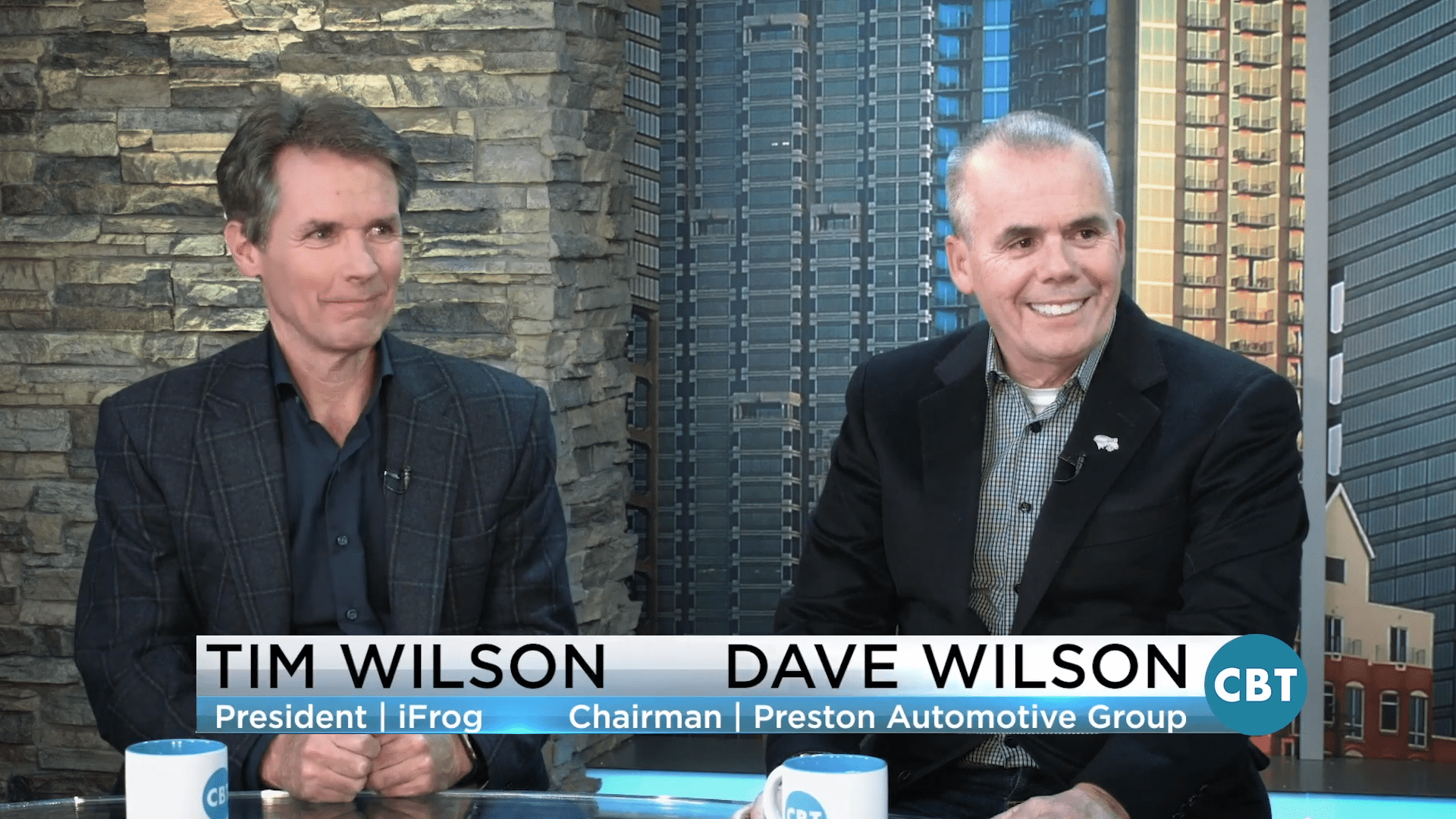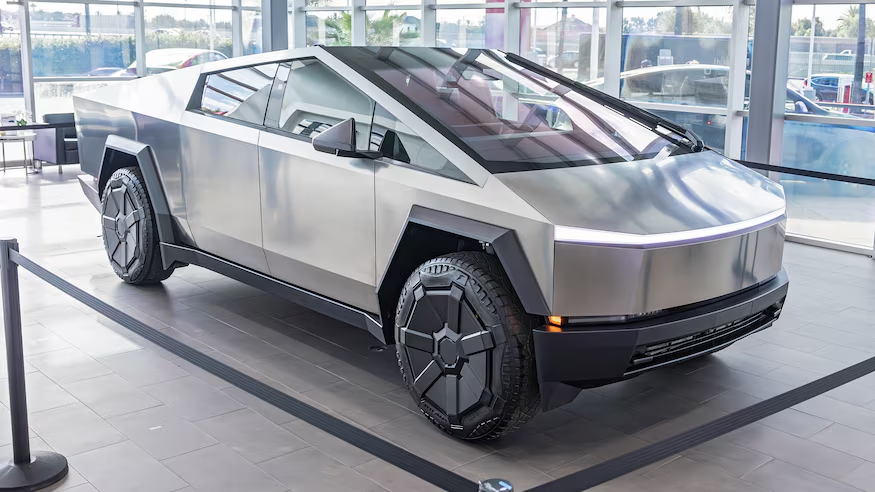On today’s show, we’re pleased to continue our conversation with Dave Wilson, Chairman of Preston Auto Group, and Tim Wilson, President of iFrog Digital Marketing.
Jim Fitzpatrick: Hello everyone. I’m Jim Fitzpatrick. Thanks so much for joining me on another edition of CBT News. Today we have with us Mr. Dave Wilson, who’s chairman of Preston Automotive Group. You probably know that name. They’ve been around a very long period of time, have 14 stores I believe in the chain, right?
Dave Wilson: Yes.
Jim Fitzpatrick: That’s phenomenal. He’s joined by Tim Wilson who is president of iFrog Marketing. Is it iFrog Marketing or Advertising?
Tim Wilson: iFrog Digital Marketing.
Jim Fitzpatrick: Digital marketing. There you go. And if you’re not doing digital marketing, get the heck out of the business, right?
Tim Wilson: We won’t go that far, but you know.
Jim Fitzpatrick: Well thanks gentlemen for joining me again at CBT News. Last time that you were in and we talked, we talked a lot about digital marketing and the role that played with one of your dealerships, but today I want to talk to you about the industry as a whole. You guys are in very unique positions to talk about this with 14 dealerships, and I think you call it the Delmarva area, right?
Dave Wilson: Yes.
Jim Fitzpatrick: That’s a pretty cool market right there. So let’s kind of jump right in here. Talk to us first of all about Preston Automotive Group. How long have you been around? How many dealerships do you have in the chain?
Dave Wilson: Yeah, we have 14 dealerships and, let’s see, 12 of them are on the Delmarva peninsula. Okay. And then we have two on what we call the Western Shore, which is across the bridge and right outside of Baltimore. So anyway, that’s… I started fresh out of sales and then-
Jim Fitzpatrick: It’s quite a success story.
Dave Wilson: Yeah. It’s been a fun ride, but I started in sales and four years later I had the opportunity at 22 years old to become a partner.
Jim Fitzpatrick: Incredible. And right out of high school, right?
Dave Wilson: Right out of high school.
Jim Fitzpatrick: You kind of bypassed college and said, “I’m getting into the car business.”
Dave Wilson: To the chagrin of my father I did.
Jim Fitzpatrick: So let’s kind of jump right in here. As you know, the auto industry is going through some major change over the last few years. There’s some disruptors out there that we hear about, companies like Carvana that will deliver a vehicle right to your front door based on the app that’s on your phone and it seems as though they’re gaining a little bit of traction. I think they sold 176,000 pre-owned vehicles last year and I don’t think they demonstrated… Put anybody in a demo drive situation on any of them. Is that a threat to our industry? Do we have to do things differently in this business in order to win back those customers or to ensure that our customers don’t go to a company like that?
Dave Wilson: Well the old saying the only constant is change, right.
Jim Fitzpatrick: Right.
Dave Wilson: Is it a threat? You can look at it at two different things. Do you step up your game? Okay, because it is a threat. There’s a lot of things that I kind of when we’re talking to in our dealership group and actually our dealer partners at iFrog. I call it the Walmart effect. Walmart’s been around a long time, but on the retail side of things they changed a lot, they really did. The convenience factor. I think the best thing to do is look internally. Look at what you’re doing. And when I’m talking about looking internally, I’m not talking about I’m looking… I’m talking about looking at yourself internally and saying, “Okay, what do I need to do to get better to make sure that I can compete with them and what’s on the horizon?”
Jim Fitzpatrick: Yeah, for sure. As you know, consumers on all the reports that are out there from Cox Automotive and JD Power and all the other surveys that are done with consumers each year, dealers don’t rank real high. I think Cox Automotive came out and said that less than 2% of people enjoyed the current way vehicles are sold and the car shopping experience or the car buying experience. So certainly the auto industry has to sit up and take notice to that, right, and change some of the things that they’re doing currently so that we’re not pushing these consumers to alternatives, whether it be a ride share company and they do away with cars altogether or companies like Vroom or Carvana.
Dave Wilson: Yes. And we have to continually, not tweak because tweak is… I think it takes too long to tweak. I think we really have to take into consideration how Carvana could sell 170,000 used vehicles. How is that and why? So again, we have to look at that. And when you peel back the onion, it’s all about convenience. It’s all about time in the showroom.
Jim Fitzpatrick: One hundred percent.
Dave Wilson: We talk about it all the time, no matter… In the car business, there’s not a department in the car business, there’s not anything that even if you look back 20 years ago, everything’s based on turn.
Jim Fitzpatrick: Yeah.
Dave Wilson: Your inventory is based on turn, your parts inventory is based on turn, your used car inventory’s based on turn, your new car inventory’s based on turn, and now the biggest thing that’s based on turn is making sure from the day that customer starts their interaction with you that you make it as quick and painless as possible.
Jim Fitzpatrick: That’s right.
Dave Wilson: And that’s another thing that’s based on turn.
Jim Fitzpatrick: When we talk to salespeople at CBT and they’ll say the dealer and the marketing will go out, and forgive me dealers, but they’ll go out and they’ll say, “Well, we’re transparent. We’re all about the customer. We want to do business the way they want to do business. We’ll get you in and out of here in no time. We want to be completely, as I said, transparent about the whole deal. You’re going to know exactly where you stand. We trust that when you’re ready to buy the car, you buy it from us without any pressure.”
Jim Fitzpatrick: Totally different story in the showroom floor with the salespeople. Don’t let that guy out of here. Make sure you don’t hit him with the right number. Hold back 1000 bucks on the trade. Don’t give him the… and the salespeople are like, “Did you see your own commercial?” You’re putting one thing out to the consumer, the consumer comes in going, “Wow, that’s where I want to do business.” And it’s a completely different approach on the showroom floor.
Dave Wilson: What we stressed, and oddly enough, all the way back to our traditional days, I grew up talking to a frog. That’s what I did.
Tim Wilson: You’re talking about marketing, not real life, right?
Dave Wilson: I grew up talking to a frog on television and my kids grew up talking to a frog on television. That gave off the aura of fun.
Jim Fitzpatrick: Oh sure, and very approachable, and that’s where I want to do business.
Dave Wilson: Right. So what we stressed, even back then is what we portray here has got to happen here.
Jim Fitzpatrick: That’s right. The dealership’s got to walk the talk.
Dave Wilson: And that’s what we were looking for back then. The thing is, we got to do it, whatever we portray online, we got to do on the showroom also. So if we say quick, fast, and painless, whatever it is, and we don’t use those exact terms, but that’s what we got to do. It’s harder to change the culture and the mindset of a salesperson than it is an actual manager a lot of times.
Jim Fitzpatrick: Right.
Dave Wilson: If you have a showroom floor of 15 salespeople, you’ve got to change 15 salespeople to do that. So that part of it’s hard, but it’s all about the culture. It’s really all about the culture. It’s all about the experience.
Tim Wilson: It is.
Dave Wilson: I didn’t mean to step on you.
Tim Wilson: No. That’s exactly correct and I think one of the other forces that’s at play that will help correct this is, I was just reading some stats on Google the other day and they were published by Google and they were talking about the increase in looking at dealer reviews over the weekend on a mobile phone, a mobile device, because they’re at the store, they’re asking these questions you’re talking about and the market’s providing a bit of a solution to that’s beyond the VSO sort of model. Here it’s like I can go online, I can look and see what someone else is doing. And so it’s this combination of culture, like you were talking about, and the forced, if you want to look at it that way, transparency that comes about through the digital age.
Jim Fitzpatrick: You all have a BDC in your dealerships?
Dave Wilson: We have a BDC for service.
Jim Fitzpatrick: Okay.
Dave Wilson: And this is just our opinion, all of our phone calls for all of our servers comes into one centralized hub.
Jim Fitzpatrick: For all the stores?
Dave Wilson: For all of our stores.
Jim Fitzpatrick: Wow.
Dave Wilson: Yes. That’s a little bit different.
Jim Fitzpatrick: Yeah.
Dave Wilson: And it’s working well. I was showing Tim a text group with the service directors this morning and they were talking about it, they were talking about the BDC in a positive way. You know what I mean? In a very positive way.
Jim Fitzpatrick: Yeah, it takes a whole boatload of aggravation off of their shoulders.
Dave Wilson: Right. And so on the sales side, even though we have a lot of clients that have BDCs on the sales side, we choose not to do that because we believe we want that relationship to start right at the beginning and the person that they deal with online they see in the showroom.
Jim Fitzpatrick: Sure.
Dave Wilson: That’s just our belief. We’ve tried it. We’ve tried it, but you know. And then we did away with BDC completely, and then we just brought back I’d say just about three years ago, we brought back BDC for service.
Jim Fitzpatrick: Okay. It seems as though in the auto industry for years, managers had to have come through the showroom floor. There’s no way to be a used car manager, new car manager, maybe even F&I manager, certainly not a GSM if you didn’t first prove yourself on the showroom floor. Talk to me about that. And do we need to revisit that a little bit?
Dave Wilson: We have.
Jim Fitzpatrick: Okay.
Dave Wilson: Okay. And we didn’t talk about that before.
Jim Fitzpatrick: Right. I’m anxious to hear.
Dave Wilson: We’ve looked at that. One of our better general managers six years ago was a bartender.
Jim Fitzpatrick: Okay.
Dave Wilson: Okay. And a lot of people our people noticed in that restaurant how he was basically commanding everything. They talked to him about sales, but they told him, we call it like a fast track program. He just sold a very short period of time.
Jim Fitzpatrick: Okay. In your eyes, did he have to be the number one salesperson or be the top dog or-
Dave Wilson: No.
Jim Fitzpatrick: Okay.
Dave Wilson: No, he didn’t.
Jim Fitzpatrick: You just wanted him to get his feet wet.
Dave Wilson: Yeah, in his case. One of our better success stories is, and I’m going to mess this up as far as what she did, she managed a lot of people and I think it was home interiors, but it was the next gen home interiors. She literally came right from that to a sales manager, now she’s a general sales manager.
Jim Fitzpatrick: That’s great.
Dave Wilson: And she never sold, not a day.
Jim Fitzpatrick: Wow.
Dave Wilson: But what we looked at was we’re a small community and she had a huge network of people she managed. Everybody except for her was probably part time, but she had that large network and we saw how she did things and she actually reached out to us and said, “I think I’m interested in the car business.”
Jim Fitzpatrick: Wow, that’s great. You brought her in as a manager.
Dave Wilson: We brought her-
Jim Fitzpatrick: Kudos to you.
Dave Wilson: We brought her in.
Jim Fitzpatrick: Wow.
Dave Wilson: Nonstop as a manager.
Jim Fitzpatrick: So there’s two things I like about that story. A, you saw the qualities in somebody that’s not on the showroom floor that you think could make a great manager without having to go through the showroom, because I’m a proponent of that as well. The other thing is you said it’s a she. So what do we need to do in this industry to attract more females into the business? Because it seems as though it’s still the good ole boy network. When you walk through many showrooms, the vast majority of the salespeople and managers and F&I people are all male, not female.
Dave Wilson: Okay. Well ,in our case of our large store that I was talking about, we have a female general manager.
Jim Fitzpatrick: Great, great.
Dave Wilson: This stat I could blow, but our service writers are probably 50/50.
Jim Fitzpatrick: Really?
Dave Wilson: Throughout our group. I do know in that store-
Jim Fitzpatrick: That’s great.
Dave Wilson: It’s 80% female.
Jim Fitzpatrick: It’s hard to get that younger college graduate female into the industry because they’re thinking, “Well if I end up getting married soon and then I have a family, this kind of goes against that.” You can’t have a young lady that’s pregnant working 65 hours a week. Right? And then of course the commission only is another problem that many females will have a problem with, many males have a problem with that as well. How do we get that good quality candidate to want to come in to the retail automotive industry? I know if my kid came in and said, I just graduated from a top school or even an okay school and I just paid a couple of hundred grand for that to happen. And they come in and say, “Hey, I think I want to go sell cars.” What am I missing here? You went to college for four years, got great grades to go sell cars? Because it’s got that kind of a stigma to it, right? Is that a challenge?
Dave Wilson: That’s a challenge, yes it is. And again, like we talked about the only thing that’s constant is change and you’ve got to be looking at every bit of that. The thing is, it goes back to what you started to talk about is that consumer experience. It really goes back to that.
Jim Fitzpatrick: That’s right, it does. One hundred percent right.
Dave Wilson: We’ve got to put all the pieces to the puzzle and we all have to be looking at it [inaudible 00:13:08] .
Jim Fitzpatrick: As I said before, you’re living proof that somebody can get into the industry and bypass college and end up with 14 dealerships. I mean, that’s still alive today in this industry. That’s how great it is. For people, for kids that come out of college or come out of high school and say, “Look, I’m going to go to work,” roll up my shirt sleeve and nose to the grind stone and they could become a dealer principal. Right?
Dave Wilson: Yeah, there’s no doubt about it. I think it might be a little bit more capital intensive than what it was when I… But then again, I was in a small market.
Jim Fitzpatrick: Yeah.
Dave Wilson: Like I said before, I do say I’m lucky because if I did what I wanted to do, I would have never had the opportunity to do what I was doing because at the time it wouldn’t have worked.
Jim Fitzpatrick: What do you think of this Park Place venture or this Park Place acquisition by Asbury for $1 billion? You’re a guy that owns 14 stores. I think that was a 17 store chain.
Dave Wilson: Yeah, 17 store chain, yeah.
Jim Fitzpatrick: If somebody gave you a billion would you call Junior and say, “Let’s go. We’re not in the car business any longer?”
Dave Wilson: We’ve had offers and that one would probably take a longer conversation.
Jim Fitzpatrick: That’s great. Well, Dave Wilson, chairman of Preston Auto Group and Tim Wilson, President of iFrog Media, thank you. Or iFrog Marketing. Advertising, marketing?
Tim Wilson: Digital marketing.
Jim Fitzpatrick: Digital marketing, that’s right. iFrog Digital Marketing. For those of you that are interested in that, check it out online. But I want to thank you gentlemen so much for giving me all the time that you’ve given me. This has been great and I know our viewers will get a lot out of it. So thank you.
Dave Wilson: We’d love to come back.
Jim Fitzpatrick: Great.
Tim Wilson: Thank you.









